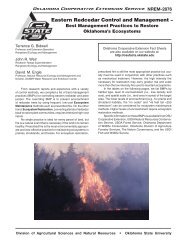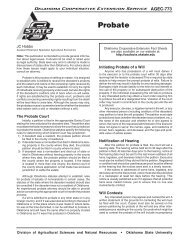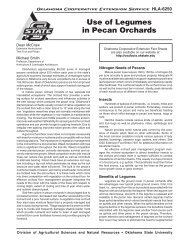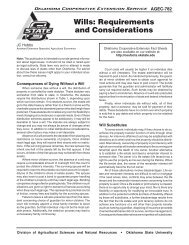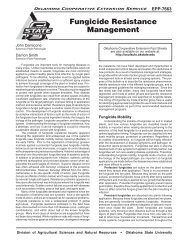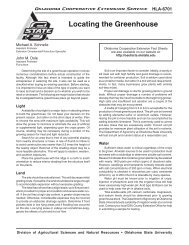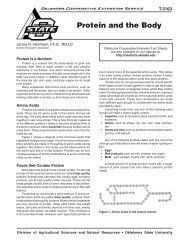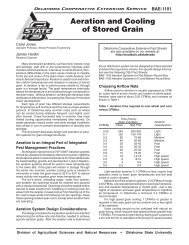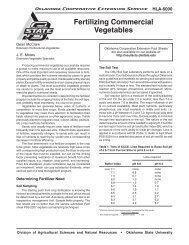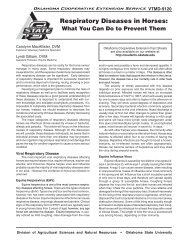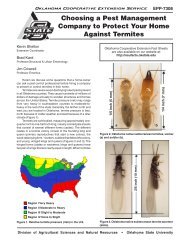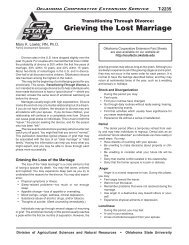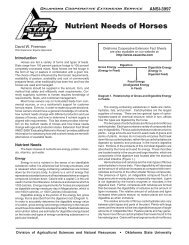Biology and Control of the Pecan Weevil in Oklahoma - OSU Fact ...
Biology and Control of the Pecan Weevil in Oklahoma - OSU Fact ...
Biology and Control of the Pecan Weevil in Oklahoma - OSU Fact ...
You also want an ePaper? Increase the reach of your titles
YUMPU automatically turns print PDFs into web optimized ePapers that Google loves.
(B) Female<br />
(A) Male;<br />
Figure 5. <strong>Pecan</strong> weevil adults show<strong>in</strong>g <strong>in</strong>sertion po<strong>in</strong>t <strong>of</strong><br />
antennae on proboscis.<br />
ment. When drought conditions persist, weevil emergence is<br />
<strong>of</strong>ten delayed till late September or even October <strong>and</strong> <strong>in</strong> some<br />
years late population peaks have occurred dur<strong>in</strong>g this time.<br />
This susta<strong>in</strong>ed emergence pattern is exactly why trapp<strong>in</strong>g <strong>and</strong><br />
monitor<strong>in</strong>g for weevils until shuck split is important. Regardless<br />
<strong>of</strong> pecan type (native vs. improved cultivar), pecan weevils<br />
will beg<strong>in</strong> oviposit<strong>in</strong>g eggs sooner on earlier matur<strong>in</strong>g nuts.<br />
After emergence from <strong>the</strong> soil, pecan weevils enter <strong>the</strong> tree by<br />
ei<strong>the</strong>r crawl<strong>in</strong>g up <strong>the</strong> bole (tree trunk) or fly<strong>in</strong>g directly to <strong>the</strong><br />
canopy or trunk. Regardless <strong>of</strong> how <strong>the</strong>y eventually enter <strong>the</strong><br />
canopy, it appears that <strong>the</strong> majority <strong>of</strong> <strong>the</strong> weevil population<br />
orients to <strong>the</strong> pecan trunk (perhaps as much as 85 percent <strong>of</strong><br />
<strong>the</strong> emerg<strong>in</strong>g population). This expla<strong>in</strong>s why trunk traps (i.e.<br />
Circle traps) are more efficient at captur<strong>in</strong>g greater numbers <strong>of</strong><br />
weevils than o<strong>the</strong>r trap types. Once weevils enter <strong>the</strong> canopy<br />
<strong>and</strong> explore <strong>the</strong> environment for food <strong>and</strong> oviposition sites,<br />
if no pecans are found (due to alternate bear<strong>in</strong>g, common <strong>in</strong><br />
unmanaged, native pecan) weevils will fly to ano<strong>the</strong>r adjacent<br />
tree or emigrate from <strong>the</strong> orchard to more suitable areas.<br />
The average longevity <strong>of</strong> adult weevils is generally between<br />
15 to 30 days; however, female weevils emerg<strong>in</strong>g beneath<br />
large-seeded cultivars can live for up to 56 days. Generally,<br />
female pecan weevils live longer than males <strong>and</strong> those that<br />
emerge early <strong>in</strong> <strong>the</strong> season live longer than those that emerge<br />
later.<br />
Fruit Injury <strong>and</strong> Damage<br />
<strong>Pecan</strong> weevils cause different k<strong>in</strong>ds <strong>of</strong> damage, depend<strong>in</strong>g<br />
on <strong>the</strong> stage <strong>of</strong> fruit development at <strong>the</strong> time <strong>of</strong> attack:<br />
• Dropped <strong>and</strong> punctured nuts caused by adult weevils<br />
feed<strong>in</strong>g on <strong>the</strong> kernel <strong>in</strong> <strong>the</strong> water stage <strong>of</strong> pecan development.<br />
The amount <strong>of</strong> feed<strong>in</strong>g damage is directly related to<br />
population density, time <strong>of</strong> emergence, <strong>and</strong> longevity <strong>of</strong><br />
weevils. On average, <strong>in</strong>dividual male <strong>and</strong> female weevils<br />
destroy 0.23 <strong>and</strong> 0.29 nuts per day, respectively. Nuts<br />
punctured late <strong>in</strong> <strong>the</strong> season (after shell harden<strong>in</strong>g) <strong>of</strong>ten<br />
rema<strong>in</strong> green <strong>and</strong> adhere to <strong>the</strong> tree past normal harvest.<br />
Shallow feed<strong>in</strong>g by male weevils after shell harden<strong>in</strong>g may<br />
impart slight scarr<strong>in</strong>g on <strong>the</strong> shell but generally results <strong>in</strong><br />
no noticeable damage to <strong>the</strong> nut meat. Females feed<strong>in</strong>g<br />
through <strong>the</strong> kernel (cotyledon) on nuts after shell harden<strong>in</strong>g<br />
can cause degradation <strong>of</strong> <strong>the</strong> gel <strong>and</strong> “sticktights”<br />
or “pops” (smaller nuts with <strong>the</strong> shuck adhered to <strong>the</strong><br />
shell) may be formed (Figure 6a). If <strong>the</strong> kernel is simply<br />
probed by <strong>the</strong> female <strong>and</strong> not fully penetrated, <strong>the</strong>n black<br />
spots, pits, or molds can occur. These spots, similar to<br />
those created by st<strong>in</strong>k bugs feed<strong>in</strong>g on pecan late <strong>in</strong> <strong>the</strong><br />
season, can make each affected kernel taste bitter <strong>and</strong><br />
<strong>the</strong>reby decrease marketability (Figure 6b).<br />
• Larval feed<strong>in</strong>g with<strong>in</strong> partially matured nuts. The grubs<br />
feed on <strong>the</strong> kernels for several weeks. Damaged mature<br />
nuts do not drop, while <strong>the</strong> larvae cont<strong>in</strong>ue to feed with<strong>in</strong><br />
<strong>the</strong> nut. This causes <strong>the</strong> shuck to adhere to <strong>the</strong> shell. Two<br />
to four larvae with<strong>in</strong> each <strong>in</strong>fested nut easily destroys <strong>the</strong><br />
entire kernel (Figure 7).<br />
• Ovipositional damage. Each female weevil can oviposit<br />
30 to 54 eggs; <strong>the</strong>refore, one weevil could affect as many<br />
as 15 to 27 or as few as 7 to 13 pecans, assum<strong>in</strong>g <strong>the</strong>re<br />
are two to four larvae per nut, respectively. When kernel<br />
formation <strong>and</strong> expansion beg<strong>in</strong>s <strong>in</strong> <strong>the</strong> pecan (near <strong>the</strong><br />
end <strong>of</strong> August) adult weevils start seek<strong>in</strong>g oviposition sites.<br />
Oviposition has been observed as early as two days after<br />
emergence; however, <strong>the</strong> average preovipositional period<br />
is about 6.5 days. Peak egg production <strong>in</strong> pecan weevils<br />
is generally reached 10 to12 days after emergence. De-<br />
A<br />
B<br />
Figure 6. ‘Sticktights’ (A) are smaller nuts with <strong>the</strong> shuck<br />
adhered to <strong>the</strong> shell. Black spots (B) from pecan weevils<br />
feed<strong>in</strong>g on pecan kernels. (Photos courtesy Jerry Payne,<br />
USDA/ARS, Bugwood.org)<br />
EPP-7079-3



